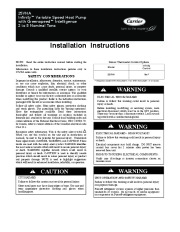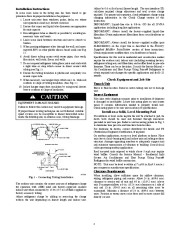| Categories | Carrier HVAC Manuals, HVAC Heating Ventilating Air Conditioning Manuals |
|---|---|
| Tags | Carrier 25VNA |
| Download File |
|
| Language | English |
| Product Brand | Support Phone Number: In North America, please call 1-800-CARRIER for immediate customer assistance from 8:00a -5:00p (EST) weekdays, Heating, Ventilating and Air Conditioning - HVAC |
| Document File Type | |
| Publisher | corp.carrier.com |
| Wikipedia's Page | Carrier Corporation |
| Copyright | Attribution Non-commercial |
25VNA Infinityt Variable Speed Heat Pump with Greenspeedt Intelligence 2 to 5 Nominal Tons Installation Instructions NOTE: Read the entire instruction manual before starting the installation. Information in these installation instructions pertains only to 25VNA series units. Indoor Thermostat Control Options Model 25VNA Infinity Control Yes* SAFETY CONSIDERATIONS Improper installation, adjustment, alteration, service, maintenance, or use can cause explosion, fire, electrical shock, or other conditions which may cause death, personal injury, or property damage.
Consult a qualified installer, service agency, or your distributor or branch for information or assistance. The qualified installer or agency must use factory-authorized kits or accessories when modifying this product. Refer to the individual instructions packaged with the kits or accessories when installing. Follow all safety codes. Wear safety glasses, protective clothing, and work gloves. Use quenching cloth for brazing operations. Have fire extinguisher available. Read these instructions thoroughly and follow all warnings or cautions included in literature and attached to the unit. Consult local building codes and current editions of the National Electrical Code ( NEC ) NFPA 70. In Canada, refer to current editions of the Canadian electrical code CSA 22.1. Recognize safety information. This is the safety-alert symbol When you see this symbol on the unit and in instructions or manuals, be alert to the potential for personal injury. Understand these signal words; DANGER, WARNING, and CAUTION. These words are used with the safety-alert symbol. DANGER identifies the most serious hazards which will result in severe personal injury or death. WARNING signifies hazards which could result in personal injury or death. CAUTION is used to identify unsafe practices which would result in minor personal injury or product and property damage. NOTE is used to highlight suggestions which will result in enhanced installation, reliability, or operation. !! * Requires model SYSTXCCUID01 V or SYSTXCCUIZ01 V or newer. ! WARNING ELECTRICAL SHOCK HAZARD Failure to follow this warning could result in personal injury or death. Before installing, modifying, or servicing system, main electrical disconnect switch must be in the OFF position. There may be more than 1 disconnect switch. Lock out and tag switch with a suitable warning label. ! WARNING ELECTRICAL HAZARD – HIGH VOLTAGE! Failure to follow this warning could result in personal injury or death. Electrical components may hold charge. DO NOT remove control box cover for 2 minutes after power has been removed from unit. PRIOR TO TOUCHING ELECTRICAL COMPONENTS: Verify zero (0)voltage at inverter connections shown on inverter cover. ! CUT HAZARD CAUTION ! WARNING UNIT OPERATION AND SAFETY HAZARD Failure to follow this warning could result in personal injury or equipment damage. PuronR refrigerant systems operate at higher pressures than standard R- systems. Do not use R- service equipment -22 -22 or components on PuronR refrigerant equipment. Failure to follow this caution may result in personal injury. Sheet metal parts may have sharp edges or burrs. Use care and wear appropriate protective clothing and gloves when handling parts. Installation Instructions In some cases noise in the living area has been traced to gas pulsations from improper installation of equipment. 1. Locate unit away from windows, patios, decks, etc. where unit operation sound may disturb customer. 2. Ensure that vapor and liquid tube diameters are appropriate for unit capacity. 3. Run refrigerant tubes as directly as possible by avoiding unnecessary turns and bends.









